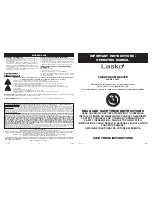
7
78570
Gas Connection
Check Gas Type. Use only the gas type indicated on the
heater's rating plate. If the gas type indicated on the plate is not
your type of gas supply, DO NOT INSTALL. Contact your
dealer for the proper model.
WARNING
DANGER OF PROPERTY DAMAGE,
BODILY INJURY OR DEATH.
Make sure the heater is equipped to operate on
the type of gas available. Models designated as
natural gas are to be used with natural gas only.
Heaters designated for use with liquefied petro-
leum (l.p.) gas have orifices sized for commer-
cially pure propane gas. They cannot be used
with butane or a mixture of butane and propane.
Gas Piping. The gas supply line must be of an adequate size
to handle the BTU/HR requirements and length of the run for
the unit being installed.
Determine the minimum pipe size from the piping size chart on
Page 9. The normal gas connection at this appliance is 1/2"
NPT made at the left of the unit.
Always use an external regulator for all LP installations to reduce
the supply tank pressure to a maximum of 14" w.c. This is in
addition to the regulator fitted to the heater.
WARNING: Connecting directly to an unregulated
LP tank can cause an explosion.
All piping must comply with local codes and ordinances or with
the National Fuel Gas Code (ANSI Z223.1), whichever applies.
Gas Line Connection
NOTE: These models are factory equipped with a stainless
steel flex tube connected to the control valve gas line inlet.
The inlet to these units is 1/2” NPT.
If installation is for L.P. gas, have L.P. installer use two-stage
regulation and make all connections from storage tank to
heater. Refer to the National Fuel Gas Code for the proper
supply tank size with the Btu's/Hr requirements. If this is the
ONLY gas appliance, we recommend a minimum 200 pound
cylinder with a fill gauge. Use of a 100 pound cylinder is not
recommended. Other household gas appliances may require
the tank size to be larger.
Use two pipe wrenches when making the connection to the
valve to prevent turning or damage to gas valve or regulator.
Connection between the manual shut-off valve and the gas
valve can be made with a CSA design certified flexible connec-
tor if allowed by local codes. A drip leg (sediment trap) must
be installed. (Fig. 5) Tighten all joints securely.
CAUTION: Failure to install a drip leg (sediment trap) may
result in improper combustion that will produce soot.
Reference Sections 3.7 and 5.5.7 and Figure 5.5.7 of the
National Fuel Gas Code for guidance.
62"
2"
Fig. 4A Minimum clearance to wall and ceiling.
10"
8"
6"
1
¹⁄₈
"
10"
Min.
15"
Min.
19"
Min.
23"
Min.
27"
Min.
Heat Resistant
Material
No Canopy Used
Fig. 4C Mantel clearances (single or multi-sided opening
fireplaces).
Fireplace Opening
Fireplace
Opening
Maximum Projection:
7”
2” Minimum
Clearance
Mantel Leg
Combustible Mantel
Noncombustible
Facing
Mantel Leg
Fig. 4B Side clearances and projection.
10"
8"
6"
1
¹⁄₈
"
8"
Min.
12"
Min.
16"
Min.
20"
Min.
Heat Resistant
Material
Fig. 4C Mantel clearance with Optional Universal Canopy.
Fireplace Opening
Universal
Canopy
Fireplace Hearth
Level






































